What’s Driving 3D Digitizing?
From dents in wings to dental impressions, physical parts need digital descriptions.
July 31, 2007
By Pamela J. Waterman
“Going deep” is a phrase no longer limited to Monday night football. The first string of users in the realms of reverse engineering, part-to-CAD inspection, and freeform manufacturing have convinced multiple levels within their business that this approach is the way to go. Where three years ago a company might have had a single seat of processing software to support a scanner or two, corporations are now purchasing dozens to hundreds of seats of digital shape sampling and processing (DSSP) packages. But you need to look at which subgroup is buying, and for which purpose.
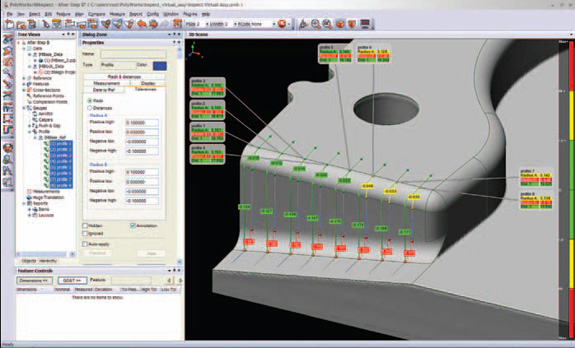 PolyWorks V10 point-cloud inspection and reverse-engineering software features the Xtreme Interface Platform.Users can customize the standard menus and toolbars, simplifying and speeding up shop-floor operations.There’s also a simplified interface with basic menus and toolbars that offers a reduced learning curve. Image courtesy of InnovMetric. |
What’s behind this deepening acceptance is a judicious response by the software developers to existing customer needs combined with intense adoption by both classic and non-traditional (non-engineering) users. While hardware technology has made great progress (faster, cheaper, more accurate), the processing side has also tackled such obstacles as ease-of-use, specialized interfaces and downstream functionality by CAD and RP systems. DE takes a look at these push/pull factors.
THE MARKET TAKES COMMAND
Read the feature list on top-ten DSSP packages or their counterpart modules within CAD software and you’ll see a great deal of overlap covering a wide range of functions. However, when you start asking questions and digging deeper, you’ll find differences that point to increasing areas of specialization. Where three to five years ago those differences were more technology driven, today’s solutions respond more to particular user needs, reflecting the beginnings of a mature market. The result is that even general DSSP software is finding great success moving deeply into niche (but not necessarily small) markets.
Take One
InnovMetric Software listened long and hard to users of their PolyWorks point-cloud processing software while developing its most recent V10 inspection and reverse-engineering products. InnovMetric president Marc Soucy explains, “We did a huge amount of work on improving usability, redesigning the computer interface from scratch. We see the need for special setups on the shop floor, for dedicated scanning, ]where] users just want the right number of buttons, with no bells and whistles.”
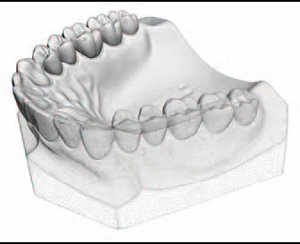 Geomagic Piano accurately reconstructs scan data of teeth, maxillary and mandibular arches, and jaw structure to facilitate the precise design of crowns,bridges, custom implant abutments and orthodontic appliances. Image courtesy of Geomagic. |
Soucy points out that traditional programming is no longer needed to create these custom interfaces. He notes, “The user can create it off the shelf, just with macros, and easily move, for example, the position of an onscreen button just by clicking and dragging the mouse.” At the same time, the company has intensely studied customer workflows to help optimize the number of clicks and movements needed to complete each inspection task.
Other new capabilities include handling both scanned and touch-probe data, conquering memory limitations with a 64-bit version of Inspector, and a new lower-priced PolyWorks/Inspector Probing package for touch-probe-only operation. In the bigger market picture, Soucy observes a demand by the larger accounts to handle the full range of what he calls hybrid metrology hardware and says they want to offer a universal platform usable across the full tier of suppliers.
Take Two
Customer requests have likewise led Geomagic, developers of Studio and Qualify point-cloud processing packages, into market niches not really foreseen even three years ago. Ping Fu, Geomagic president and CEO, explains that in each of its three main markets — automotive, aerospace, and medical — they’ve created turnkey applications that are huge business for them now.
“An area where DSSP has penetrated deeply is in capturing the existing shape of engine and transmission housings, which are very complex shapes,” says Fu, adding that after tooling and casting, as-built is usually different than as-designed. “FEA and CFD engineering is fueling the demand of DSSP technology to take the as-built model for analysis.”
Other Takes
Other customer-driven tasks involve inspecting stamped sheet-metal and supporting aerospace maintenance, repair and overhaul (MRO) tasks. Yet even these large application areas pale when compared to the numbers in the dental world, where 1.2 million doctors perform 110,000 treatments a year. Point-cloud scanning systems with consumer-level ease of use are now providing the convenience and time-savings of digital file creation as the basis for machine-made dental and orthodontic appliances.
WHAT’S DOWNSTREAM?
At some point, all DSSP vendors must address the question, what does our output look like? For most systems, the answers are one or more of an STL file, an IGES standard format file or a series of NURBS (non-rational uniform B-spline) surfaces fitted to the data. Offering all these options for all applications runs the risk of not doing any of them well, so the vendors continue to specialize.
| Coming to terms with 3D Digitizing Ping Fu, Geomagic President and CEO, has promoted the use of DSSP — digital shape sampling and processing — as an overall term to encompass and allow for the many hardware and software aspects of reverse engineering, inspection, data archiving, medical modeling and other digitizing tasks. She explains, “We needed a name that we ]vendors] could all attach to, so that analysts could cover that space.” It makes sense especially when you think that the terms DSP (digital signal processing) and DIP (digital image processing) were both originally technology-driven but now focus on user applications. —PW |
Materialise Software saw the need to offer a “super mesh editor” that bypasses the mesh-to-CAD and back-to-mesh stages, which often result in large geometry deviations. Jon Moss, Materialise Software Services Engineer, says its goal is to bring design tools directly to the STL file. With the 3Matic package, users repair, reconstruct and manipulate scanned data directly into a mesh ready for FEA and CFD, or as input for a solid-freeform (rapid prototyping) system. The software can also import existing CAD data for part comparison, or merge CAD data into the same file at the polygon level.
How are other major players in this field meeting customer needs? For the past eight years, UGS PLM focused its Imageware product line on Class A (extremely accurate) surfacing, primarily for certain automotive clients. More recently, according to UGS’ Matt Kreuzwieser, those OEMs have come full-circle, re-recognizing the need and value of reverse engineering (RE), both in the concept-styling domain and mold or die manufacturing.
The OEMs want NX software to be easily usable down to the shop-floor level by non-technical, non-expert staff around the world. An example Kreuzwieser cites is that of a company having built a 20-ton die in Brazil, but deciding that shipping costs to Detroit were prohibitive. The company found it cheaper to scan it as-built, then send the data north and duplicate it in place. A similar application is simply that of capturing die information for archival storage; if the die is damaged down the road, they can readily build the same part again.
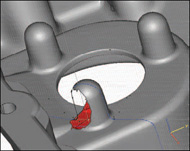 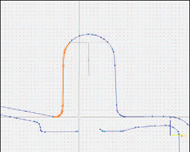 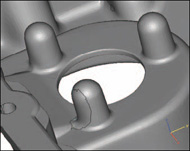 Materialise Software offers a “super mesh editor”that bypasses the mesh-to-CAD and back-to-mesh stages. From left: Scan data for a broken part, 3Matic software is used to take point-cloud data and construct a 3D part fill-in while in the STL environment, and finally, the repaired STL part file. |
Dassault Systemes’ recent purchase of ICEM brings even more power to this well-known developer of Class A surfacing systems. ICEM Product Marketing Manager Pete Moorhouse comments that there is still resistance to “the completely digital car” and therefore there is still a great need for digitizing clay models with all their nuances. But, he adds, “In the last five years customer demand has led to further enhancements in the functionality of our solutions. The need for a ‘semi-automatic’ or ‘one-hit’ surface model drove the development of quick surfacing tools.”
| Orametrix scanning system shortens orthodontic treatment time Proving there’s still a place for third-party proprietary software, Orametrix (orametrix.com), a specialized dental equipment provider, offers a turnkey orthodontic-appliance fitting system based on DSSP software from a German developer. Technicians use a handheld white-light scanner hardly bigger than a toothbrush to generate a point-cloud image directly from patients’ teeth. The scanned data is automatically retrieved by the Orametrix processing center, transformed into a 3D model, and sent back to the orthodontist for guided treatment-simulation. —PW |
Metris, another long-time player in the DSSP field, takes a different, broader view of fulfilling customer needs. It provides complete hardware and software metrology solutions for both point-cloud and touch-probe operations, regardless of vendor source, and is particularly focused on lifetime customer service.
Jim Clark, Metris USA VP of Marketing and Business Development, says that his company’s own software line, formerly CadCompare and Paraform, is now split into Focus Inspection and Focus RE, with the majority of business going to inspection. He says that point-cloud inspection is growing in popularity, but that geometric dimensioning and tolerancing (GD&T) capabilities are still very important.
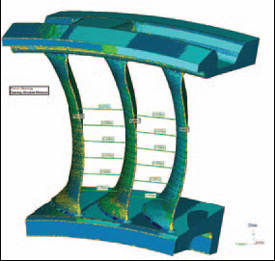 Multiple airfoil analysis in Geomagic Blade enables the evaluation and reporting of dimensions related to turbine segments for use in the aerospace industry. Image courtesy of Geomagic. |
What he’s not seeing is the massive demand for RE that was predicted in the late ’90s, saying, “The ]market] element that has breakout capacity is part-to-CAD inspection, ]yet] a lot of people don’t understand what’s involved. It’s not about the scanning hardware, it’s about postprocessing, and what you can do with the points.”
Clark believes that most companies want straightforward point-and-click operations for use by their inspection staff, with the software interface reflecting the actual process flow. Metris offers customized solutions to do so.
NOW AVAILABLE: SCAN TO PARAMETRIC CAD
For many cases, the above options are either good enough, fast enough, or just the right price…or perhaps not. An STL file won’t work as input to a CAD program. Some people take issue with the quality of an IGES intermediary step before CAD file creation. And lastly, the details of a captured surface may be a great deal more useful if converted into a fully parametric CAD model.
Several years ago INUS Technology made the first steps toward the latter goal, adding Feature Workbench to its general processing package. Since then, the company has focused intensely on these issues, completely rewriting the software’s architecture based on licensing the Parasolid kernel. The strategy was to bring CAD into the DSSP world, putting parametric modeling capabilities directly onto the scanned data. The result is RapidForm XOR, launched just a year ago.
Tom Charron, INUS North American regional manager, explains, “Users want a fully editable model. To offer that, we had to go back to the drawing board and build a parametric modeling system. XOR is very different from earlier ]processing] forms that used to grab the mesh and shrink-wrap a surface around it. Here, you actually redesign the model on top of the scan data — kind of creating the part from scratch on top of a template formed by the scan data.”
These functions can still be done in CAD programs, but Charron says each step takes time. Creating a variable radius fillet on a “dumb” surface the traditional way could take an hour; with XOR the same operation takes 15 seconds. INUS also offers XOS, a less expensive package that stays with the STL format for RE purposes, XOV, a part-to-CAD verifier, and the special $2500 RapidWorks package that works with NextEngine scanners to create SolidWorks files.
MORE PLAYERS ON THE FIELD
Dassault Systemes ICEM
Southfield, MI
icem.com
Delcam
Windsor, ON, Canada
delcam.com
Geomagic
Research Triangle Park, NC
geomagic.com
HighRES
La Jolla, CA
reverse-it.com
INUS Technology
Sunnyvale, CA
rapidform.com
Materialise
Ann Arbor, MI
materialise.com
Maya Metrix
Montreal, QUE
mayametrix.com
McNeel North America
Seattle, WA
rhino3D.com
Metris USA
Rochester Hills, MI
metris.com
NextEngine
Santa Monica, CA
nextengine.com
Orametrix
Richardson, TX
orametrix.com
Revware
Raleigh, NC
revware.net
SolidWorks
Concord, MA
solidworks.com
UGS PLM Solutions
Plano, TX
ugs.com
Verisurf
Anaheim, CA
verisurf.com
Contributing Editor Pamela J. Waterman is an electrical engineer and freelance technical writer based in Arizona. You can contact her about this article via e-mail sent to DE-Editorsmailto:[email protected].
Subscribe to our FREE magazine, FREE email newsletters or both!
About the Author
Pamela Waterman worked as Digital Engineering’s contributing editor for two decades. Contact her via .(JavaScript must be enabled to view this email address).
Follow DE





